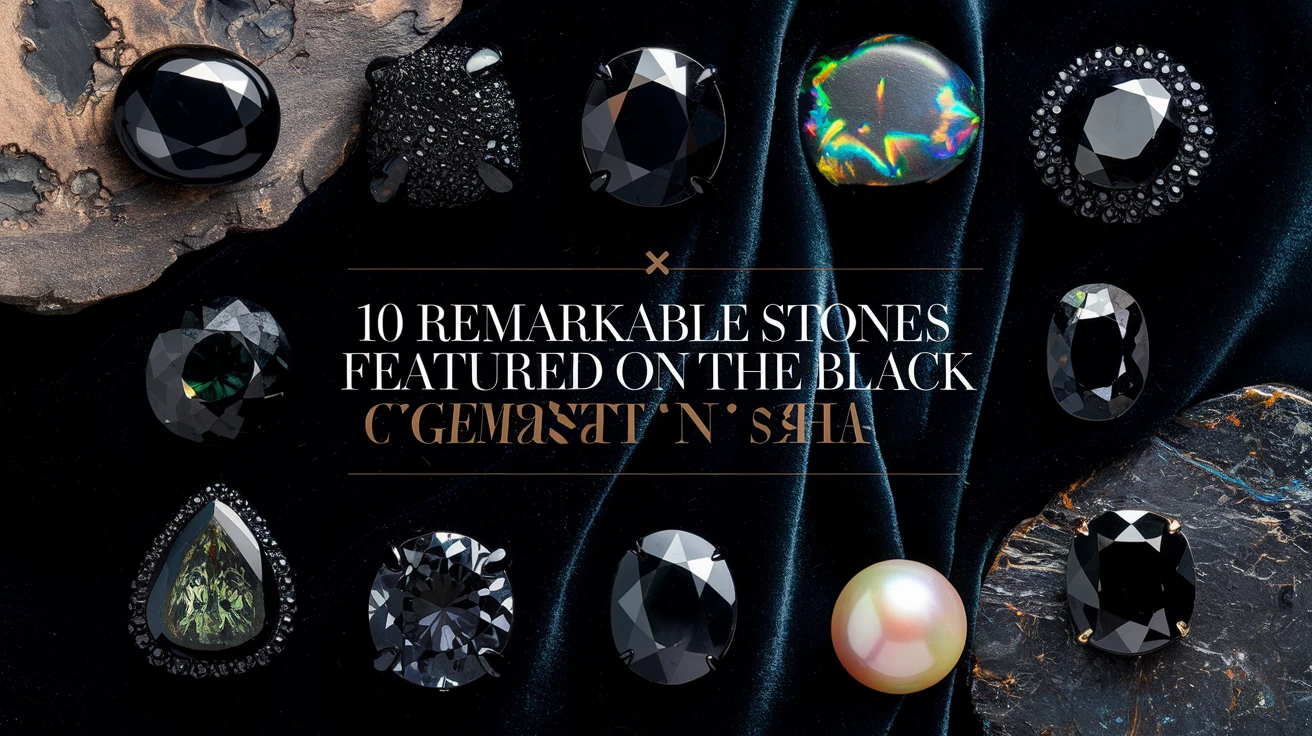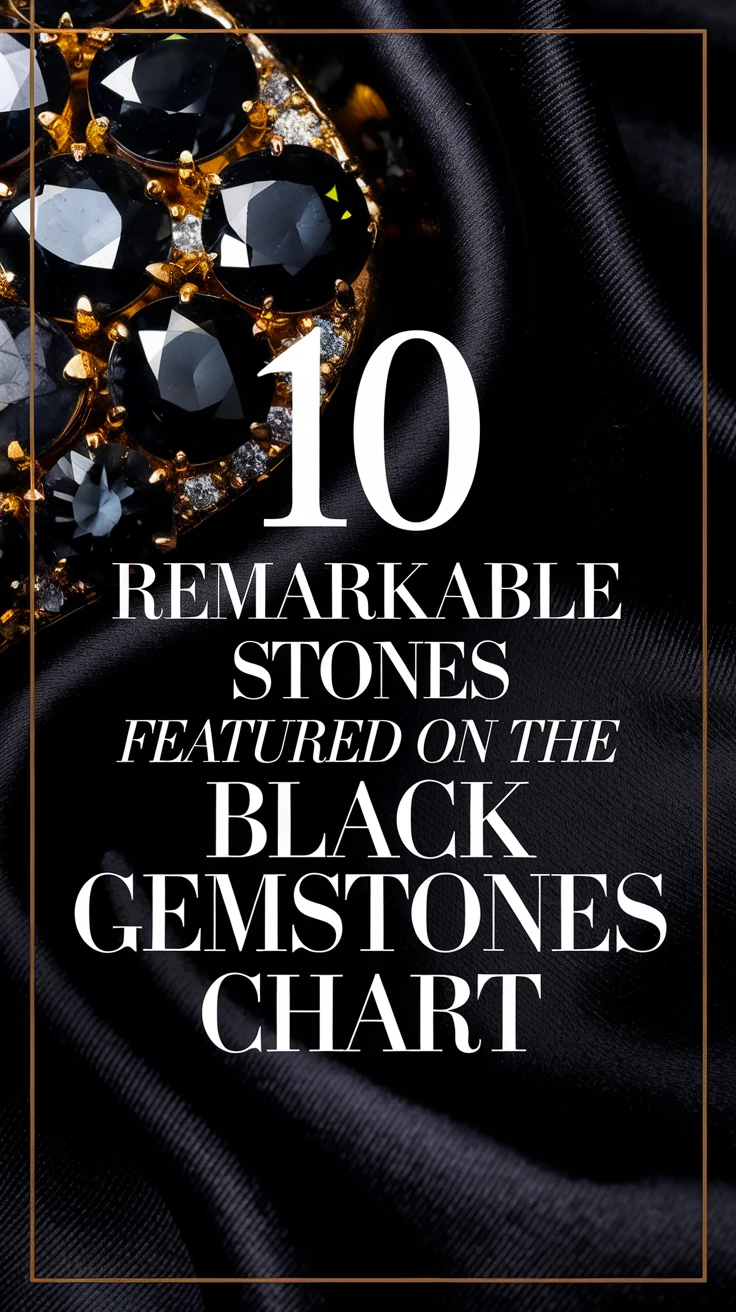
Introduction to Black Gemstones
The mysterious allure of black gemstones has captivated humans for millennia. When exploring the black gemstones chart, you’ll discover a fascinating world of stones that range from deeply opaque to mysteriously translucent. These remarkable gems not only make stunning jewelry pieces but also carry profound spiritual significance across various cultures.
Whether you’re a collector, jewelry enthusiast, or someone interested in the metaphysical properties of stones, understanding the black gemstones chart can help you make informed decisions about these captivating minerals. Let’s explore ten of the most remarkable black gemstones, each with its unique characteristics and appeal.
| Property | Range | Importance |
|---|---|---|
| Hardness | 3-10 Mohs | Durability |
| Transparency | Opaque to Transparent | Appearance |
| Value | $10-$50,000 per carat | Investment |
1. Black Diamond
At the top of the black gemstones chart sits the magnificent black diamond, a stone that combines ultimate hardness with sophisticated elegance. These rare gems get their color from numerous dark inclusions of graphite, pyrite, or hematite.
- Hardness: 10 on Mohs scale
- Natural black diamonds are extremely rare
- Most commercial black diamonds are treated
- Highly valued in modern jewelry design
Black diamonds have gained popularity in recent years, particularly in engagement rings and statement pieces. Their durability makes them perfect for everyday wear, while their unique appearance sets them apart from traditional clear diamonds.
Pro tip: When purchasing a black diamond, always request certification to verify whether it’s natural or treated, as this significantly affects its value.
2. Black Onyx
Black onyx is perhaps the most recognized stone on the black gemstones chart, celebrated for its deep, pure black color and glossy finish. This variety of chalcedony has been used in jewelry and decorative arts since ancient times.
- Perfectly uniform black color
- Excellent for carving and beading
- Historically used in signet rings
- Affordable and widely available
While most black onyx on the market today is color-enhanced, this treatment is stable and accepted in the industry. The stone’s versatility and affordability make it a popular choice for both fashion jewelry and men’s accessories.
Pro tip: Look for black onyx with a high polish and no visible banding for the most desirable pieces.
3. Black Tourmaline
Black tourmaline, also known as schorl, is a fascinating entry on the black gemstones chart, known for its protective properties and striking appearance. This crystal forms in long, striated columns and is highly prized by both collectors and metaphysical practitioners.
- Natural pyroelectric properties
- Strong protective energy
- Complex crystal structure
- Often displays subtle blue or green undertones
Black tourmaline’s unique ability to become electrically charged when heated or cooled makes it particularly interesting to scientists and crystal enthusiasts alike. Its natural formation often results in beautiful striations that add character to each piece.
Pro tip: Keep black tourmaline away from prolonged sunlight to maintain its deep color and energetic properties.
4. Black Opal
Among the most valuable entries on the black gemstones chart, black opal stands out for its remarkable play of color against a dark background. These rare gems primarily come from Lightning Ridge, Australia, and display vibrant flashes of color across the spectrum.
- Exhibits stunning play of color
- Extremely rare and valuable
- Natural dark body tone
- Requires special care and handling
Black opals are considered the most precious variety of opal, with their dark body tone providing the perfect canvas for the stone’s famous play of color. The finest specimens can command prices higher than diamonds of comparable size.
Pro tip: When selecting a black opal, prioritize brightness and pattern over size for the best value.
5. Black Pearl
Though technically not a gemstone, black pearls earn their place on the black gemstones chart through their incredible beauty and rarity. These organic gems, primarily from Tahiti, display iridescent overtones that can include peacock green, purple, and blue.
- Natural black pearls are extremely rare
- Displays unique overtones
- Requires special care
- Primarily cultured in Tahitian waters
Black pearls are among the most mysterious and sought-after organic gems, with their dark body color resulting from the unique properties of the Pinctada margaritifera oyster.
Pro tip: Store black pearls separately from other jewelry to prevent scratching, and wipe them with a soft cloth after wearing.
6. Black Sapphire
Black sapphire represents the darker side of the corundum family on the black gemstones chart. While not as famous as its blue counterpart, black sapphire offers excellent durability and an understated elegance.
- Hardness of 9 on Mohs scale
- Often used as a diamond alternative
- Natural and treated varieties available
- Excellent durability for everyday wear
Black sapphires provide an affordable alternative to black diamonds while maintaining excellent durability and a sophisticated appearance. They’re particularly popular in men’s jewelry and modern designer pieces.
Pro tip: Look for stones with slight transparency when held up to strong light for the best quality.
7. Black Spinel
A notable entry on the black gemstones chart, black spinel is gaining recognition for its natural beauty and excellent optical properties. This stone offers a perfect combination of durability and affordability.
- Natural untreated black color
- Excellent luster and brilliance
- Hardness of 8 on Mohs scale
- More affordable than similar-looking stones
Black spinel is increasingly popular among designers who appreciate its natural beauty and durability. Unlike many black stones, it rarely requires treatment to achieve its color.
Pro tip: Choose black spinel for everyday jewelry pieces as it offers excellent durability at a reasonable price point.
8. Black Obsidian
This volcanic glass holds a unique position on the black gemstones chart as a naturally occurring glass rather than a crystal. Black obsidian’s smooth, glossy appearance and sharp edges make it instantly recognizable.
- Formed from rapidly cooled lava
- Perfect for scrying and meditation
- Extremely sharp when broken
- Requires careful handling
While technically a mineraloid rather than a true mineral, obsidian’s historical significance and modern applications in jewelry and metaphysical practices make it an important black stone to consider.
Pro tip: Store obsidian pieces separately to prevent scratching, as it’s relatively soft compared to other gemstones.
9. Black Star Diopside
One of the more unusual entries on the black gemstones chart, black star diopside displays a remarkable asterism effect when properly cut. This rare phenomenon creates a striking star pattern on the stone’s surface.
- Displays distinct star effect
- Natural and untreated
- Relatively rare
- Requires expert cutting
Black star diopside offers a unique alternative to more common black stones, with its star effect providing an interesting optical display that sets it apart from other black gems.
Pro tip: View potential purchases under different lighting conditions to ensure the star effect is visible from various angles.
10. Black Jade
Completing our exploration of the black gemstones chart is black jade, a stone with deep cultural significance, particularly in Asian cultures. This dense, fine-grained stone takes an excellent polish and has been carved into elaborate artifacts for thousands of years.
- Cultural significance in many societies
- Excellent for carving
- Durable and tough
- Various degrees of transparency
Black jade’s cultural importance and versatility make it a significant stone for both collectors and jewelry enthusiasts. Its smooth, cool texture and rich history add to its appeal.
Pro tip: When selecting black jade, look for pieces with even color distribution and no visible fractures.
Key Takeaways
- Black gemstones vary significantly in hardness, value, and origin
- Natural black colors are rare in many gemstone varieties
- Each stone offers unique properties and benefits
- Proper care and handling are essential for maintaining appearance
- Authentication and certification are important for valuable specimens
Conclusion
The black gemstones chart reveals a fascinating world of dark-colored minerals, each with its own unique properties and appeal. From the prestigious black diamond to the mysterious black opal, these stones offer something for every collector, jewelry enthusiast, or metaphysical practitioner. Understanding these remarkable stones helps in making informed decisions whether you’re purchasing for investment, adornment, or spiritual purposes.
Frequently Asked Questions
What is the most valuable black gemstone?
Natural black diamonds and black opals are typically the most valuable black gemstones, with prices varying significantly based on quality and size.
How can I tell if a black gemstone is real?
Professional certification, specific gravity tests, and examination under magnification by a qualified gemologist are the most reliable methods for authentication.
Which black gemstones are the hardest?
Black diamond ranks highest at 10 on the Mohs scale, followed by black sapphire at 9, and black spinel at 8.
Are black gemstones natural or treated?
While some black gemstones are naturally black, many commercial specimens are treated. Always ask about treatments when purchasing.
How should I clean black gemstones?
Most black gemstones can be cleaned with warm soapy water and a soft brush, but specific care requirements vary by stone type.

